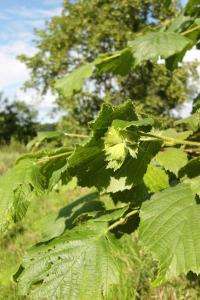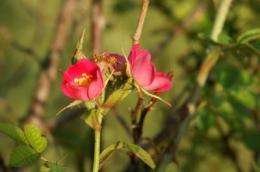Chile is more dangerous for Argentina than vice versa

Invasive plant species in Chile pose a higher threat to its neighbour, Argentina, than vice versa. This was concluded by scientists from the University of Concepción in Chile and the Helmholtz Centre for Environmental Research (UFZ) after analysing the flora of both countries. In particular, 22 non-native species which occur in Chile on connecting roads leading to Argentina present a high risk according to the researchers, writing in the journal Biological Invasions.
Trade between Chile and Argentina mainly takes place by road. Over the past decade, the quantity of road freight between the two countries has more than tripled. Although the Andes once functioned as a natural barrier between both countries, the mountain range has been made increasingly porous by the increase in transport. Of the 875 alien species, nearly 300 occur only in Chile and the same quantity solely in Argentina while more than 300 are found in both countries. Invasive species can disturb ecosystems and cause severe damage to agriculture.
Researchers say the most dangerous species for the neighbouring country is yellow glandweed or yellow bartsia (Parentucellia viscosa), an annual herb native to the Mediterranean region which has already spread into 10 provinces of Chile within 48 years. "In our view, particular attention should be paid to shrubs and trees," concludes Dra Nicol Fuentes. "Species like the elmleaf blackberry (Rubus ulmifolius), sweet briar rose (Rosa rubiginosa) and silver wattle (Acacia dealbata) will be difficult to eradicate because they are now so widespread. However, we're still optimistic regarding the Portuguese broom (Cytisus striatus), which is only just starting to spread."
In the biologists' view, it is important for scientists and other experts to set priorities for measures to counter invasive species. "Cooperation between neighbouring countries in the joint planning of countermeasures would be the most effective way of investing taxpayers' money into the prevention and control of invasive plant species. This was shown by our investigation," explains Dr Ingolf Kühn from UFZ.
Two years ago, the combined team of researchers from Chile and Germany evaluated the development of flora in Chile since 1900. Of the more than 70,000 samples in the herbarium at the University of Concepción, they identified 1,997 indigenous and 629 non-native plants. It turned out that within the space of a single century, invasive species had spread almost throughout the territory. The centre of this spread is the Mediterranean climate zone, where the Spanish colonial rulers began introducing farming from their European homeland in 1520. When Chilean agriculture and hence also grain production grew rapidly between 1910 in 1940, the invasive species spread swiftly.

In order to assess the risk resulting from certain species, the researchers used a method from Australia, where plant species from Europe are also a problem. Australian, Czech and German scientists demonstrated in a recently published study that 750 plant species from central Europe are now to be found in Australia. Most of the species arrived between 1840 and 1880 as well as between 1980 and the present, reflecting the waves of immigration. And around two thirds of them were deliberately introduced into Australia. They include many species used to decorate gardens such as the common ash (Fraxinus excelsior) and common beech (Fagus sylvatica). The first species thought to have arrived is the common hazel (Corylus avellana), which was first sold at Australian tree nurseries in 1803. In 1843 it was joined by the Norway maple (Acer platanoides), which was popular among landscape planners when laying out avenues. Given the presence of so many non-native species, researchers expect that others will take hold and spread invasively – albeit with some delay.
More information: Publications:
Fuentes, N., Ugarte, E., Kühn, I., Klotz, S. (2010): Alien plants in Southern South America. A framework for evaluation and management of mutual risk of invasion between Chile and Argentina. Biological Invasions 12: 3227-3236.
dx.doi.org/10.1007/s10530-010-9716-9
Phillips M. L., Murray B. R., Pyšek P., Pergl J., Jarošík V., Chytrý M. & Kühn I. (2010): Plant species of the Central European flora as aliens in Australia. – Preslia 82: 465-482.
www.ibot.cas.cz/preslia/P104Phillips.pdf
Fuentes, N., Kühn, I., Ugarte, E., Klotz, S. (2008): Alien plants in Chile. Inferring invasion periods from herbarium records. Biological Invasions 10: 649-657.
dx.doi.org/10.1007/s10530-007-9159-0
Provided by Helmholtz Association of German Research Centres

















